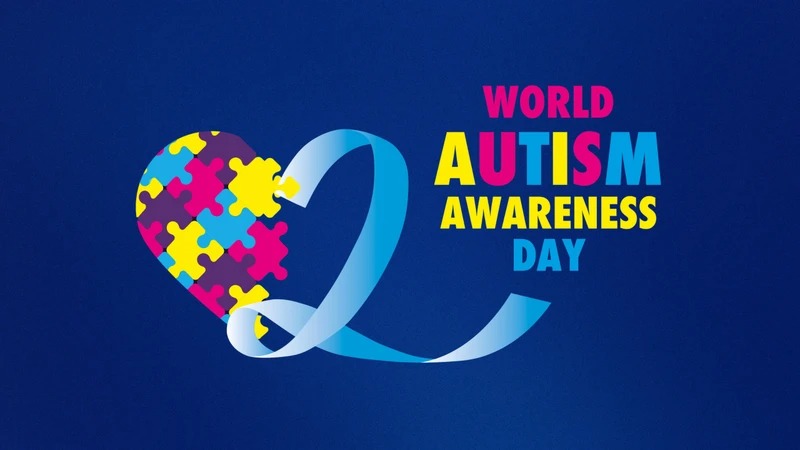April 2nd of each year is chosen by the United Nations as World Autism Awareness Day with the aim of calling on the community to increase attention and understanding of this disorder, helping autistic children to be detected early, treated, loved more and integrated into life more easily.
April 2nd of each year is chosen by the United Nations as World Autism Awareness Day. |
In 2024, the Department of Psychiatry, National Children's Hospital received over 45,000 children for general mental health examination, of which approximately 20% of cases were examined with some signs of suspected autism.
On average, there are about 10,000 children diagnosed with autism at the National Children's Hospital each year. According to major studies around the world, the rate of autistic children accounts for about 1% of the population. In Vietnam, this number is also predicted to be similar.
MSc. Nguyen Mai Huong, Deputy Head of the Department of Psychiatry, National Children's Hospital, said that in 2018, the National Children's Hospital coordinated with the University of Public Health to conduct a national study to screen children under 6 years old at 7 locations representing regions in Vietnam.
The results showed that the rate of children with autism under 6 years old is about 0.7%. "If we expand the study to children over 6 years old, we think this number will be even higher," Dr. Mai Huong affirmed.
Recently, at the National Children's Hospital, the rate of parents bringing their children for early check-ups, before the age of 2, has been increasing. This shows that when there are only vague signs, parents are worried and take their children for early check-ups to find out the cause of their slow development.
In the 2024 year-end report, the Department of Psychiatry received over 45,000 visits to the General Mental Health Department, of which approximately 20% were for suspected autism. Thus, each year approximately 10,000 children were examined for autism.
Recently, the story of a 17-year-old girl in Hai Phong has made us feel heartbroken. TLD, a naive girl, stood on a bridge, preparing to jump down to end her life.
She was not the first to contemplate suicide, and she may not be the last. But the important thing is that she was saved in time, saved from the abyss of despair. However, the question remains: How many other children, in their weakest moments, are falling into similar situations without anyone knowing?
Children and adolescents, in the process of growing up, face strong psychological and physiological changes. When faced with pressures from studying, relationships with family, friends, or even changes in their bodies, many children cannot find a way out for their negative emotions.
These children are not only suffering from physical pain, but are also suffering from mental confusion. According to Ms. Nguyen Mai Huong, children often do not know how to handle negative emotions and do not know how to seek support.
When they cannot find a way out, they easily fall into negative thoughts and push themselves to the brink of death. This makes us even more heartbroken when we think of children who are suffering alone in the dark.
It is undeniable that one of the main reasons that makes adolescents fall into a state of despair is the lack of care and support from relatives, family, and the surrounding environment.
Children often do not know how to express their feelings, and sometimes the feeling of being forgotten and not understood makes them fall into depression, leading to negative decisions. These children, although not directly speaking out, but in their hearts, loneliness and fatigue have eroded their souls, making them no longer see the reason to continue living.
In many cases, children face a sense of guilt and enormous pressure from their studies. High expectations from family and society, combined with the inability to complete these tasks, make children feel like failures.
These pains gradually accumulate and create depression, causing children to withdraw and not want to share with anyone. This not only pushes them into negative thoughts but also increases the risk of suicide. Children feel worthless, not worth living, and in a moment of weakness, the decision to give up life seems to become the only way to escape the pain.
However, if we are more observant and pay more attention to changes in children's behavior and emotions, it becomes possible to identify and prevent suicide risk.
Warning signs of suicide in children are often difficult to recognize because children do not often express negative thoughts directly. However, we can still identify changes in behavior, mood, or daily habits.
They may become more passive, interact less with people, lose interest in activities they once enjoyed, or even appear depressed and hopeless.
Sometimes, statements like "I don't deserve to live," "Everything is meaningless," or "Life is a failure" are clear signs of despair. If your child begins to express such thoughts, it is time for the family and those around them to take timely action to get the child the help he or she needs.
It is impossible to stand by and watch when a child is suffering alone. Family is the first and most important place for a child to feel loved and understood.
Parents need to listen to their children in a non-judgmental way. Sometimes a simple question like “Are you okay?” or a warm hug can help a child feel like they are not alone.
Parents need to create a safe space for children to feel comfortable sharing their feelings without fear of being criticized or judged. In particular, when noticing negative signs, parents need to proactively find ways to help their children, perhaps by taking them to psychological experts or directly supporting them to overcome the difficulties they are facing.
In addition to the family, schools also play an extremely important role in detecting and preventing the risk of suicide in children. Schools are not only places to impart knowledge but also an environment that helps children form their personality and emotions.
Teachers need to pay attention to students’ mental health, not only in the classroom but also in extracurricular activities. School counseling programs help students realize that they do not have to face their problems alone. Children need to feel that school is a place where they can express their worries and fears without fear of being stigmatized or rejected.
The community also needs to take responsibility in creating a friendly environment to help children with psychological difficulties. We cannot stand by when we see children facing problems that cannot be solved.
Social and community organizations must be more active in providing information and psychological support to children, while encouraging the elimination of stigma against mental health problems.
Ultimately, nothing is more important than making sure our children never have to suffer alone.
Every child deserves a happy life, and we - adults - must be the ones to help them find hope and faith in life. Don't let them find their own way out in despair. Don't let them fall into the darkness without anyone knowing.
Autism is a neurodevelopmental disorder that impairs communication skills, speech, and social interaction.
Source: https://baodautu.vn/ngay-the-gioi-nhan-thuc-ve-tu-ky-chung-tay-hanh-dong-de-giam-ty-le-tu-ky-o-tre-em-viet-nam-d261448.html



































































































Comment (0)